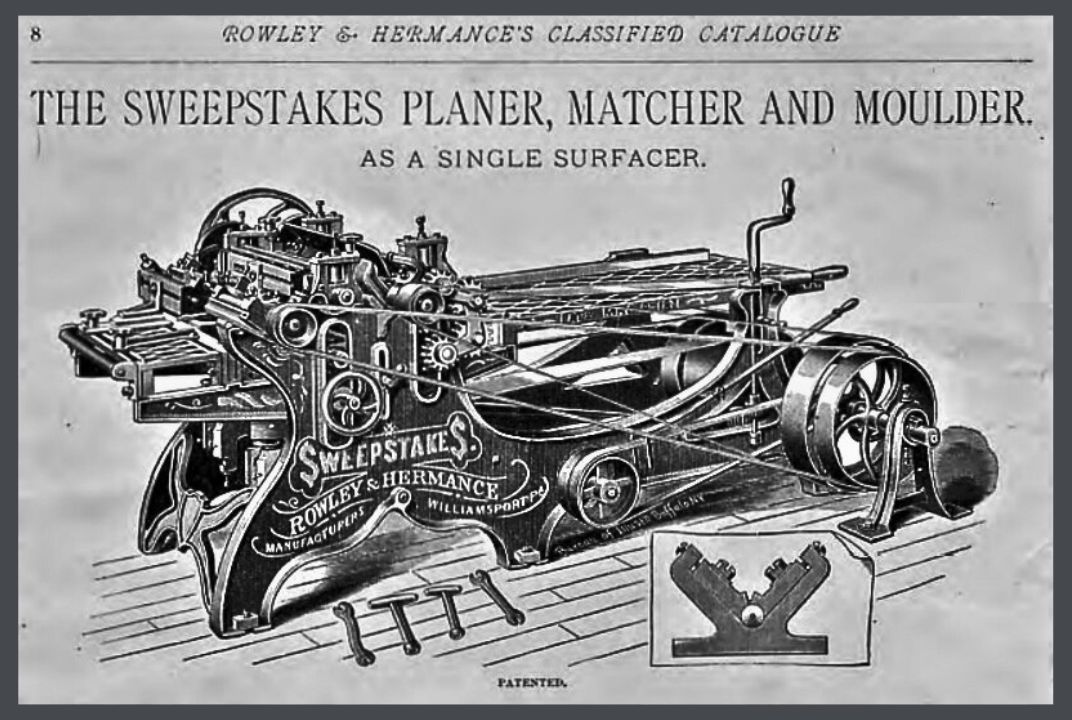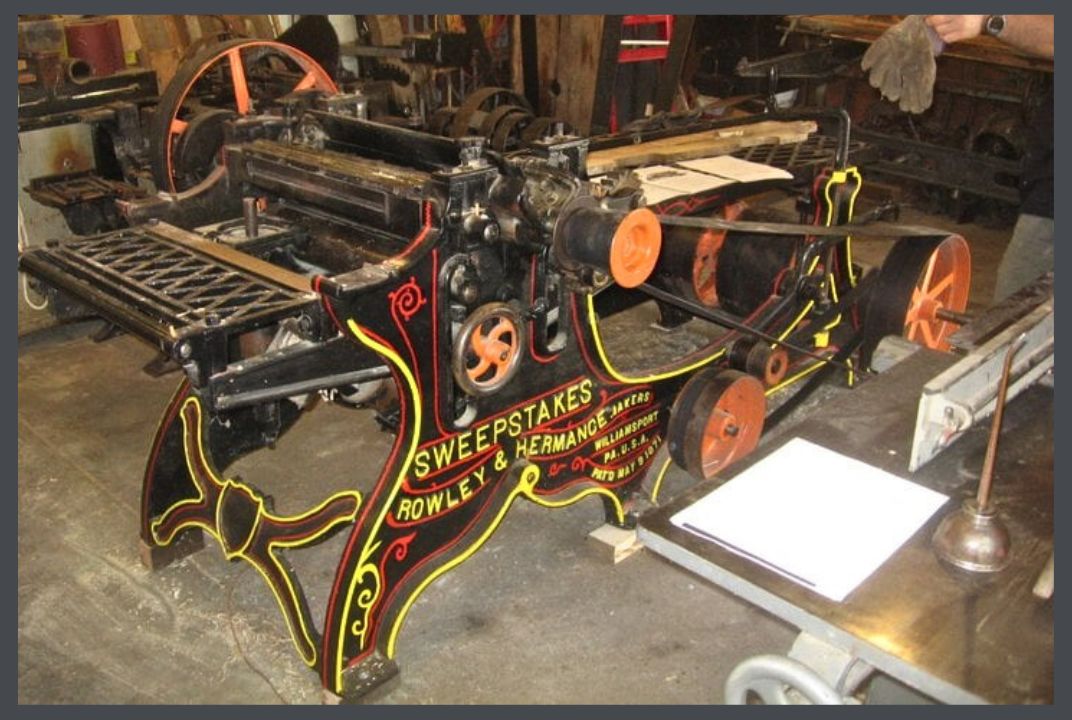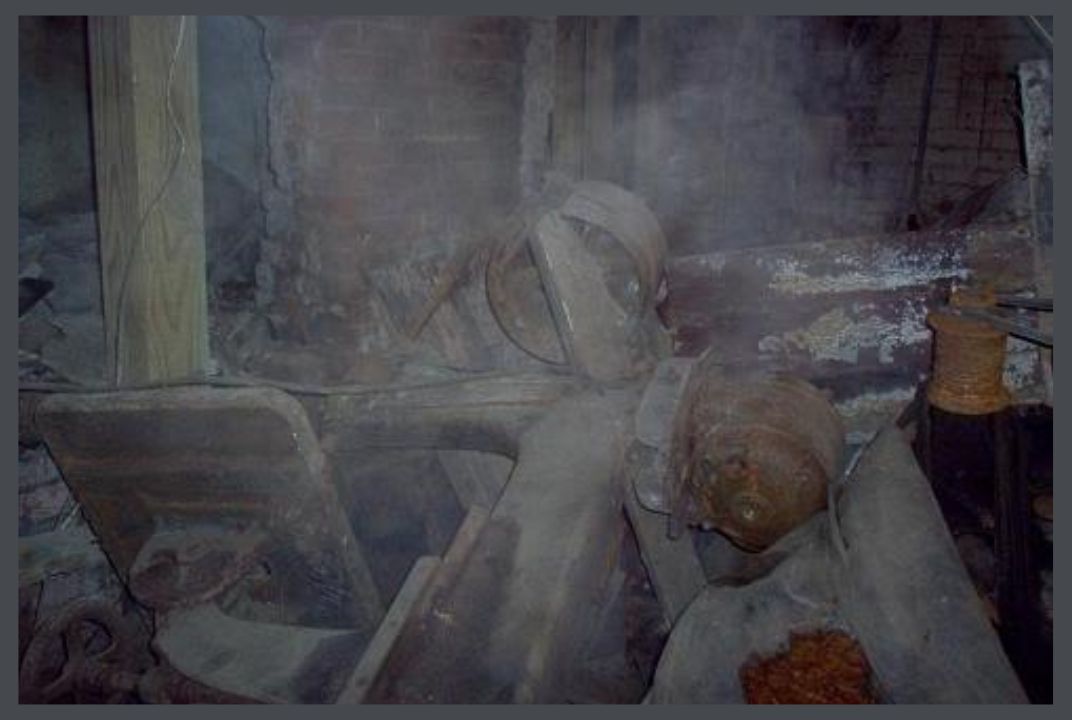MORE LESSONS, LEARNED THE HARD WAY

4 head Jos. O Colladay molding machine
This is post #3 in a series about how I got into restoration. At this point I was putting together the millwork shop.
In January of 2003, a whole barn full of machines came up for sale on eBay. I was interested in only one of these, an 1880’s Jos. O. Colladay 4 head molding machine. I knew that this type machine made all the straight moldings for houses in that era. It closely resembled the drawings in the 1880 Census Report.
I waited until the last 30 seconds of the auction to put in my high bid of $202.50. I won. It was located in Schuylkill Haven, PA, a bit over 800 miles from me. In those days, gas was cheap, and I could drive that far and back for a little over a hundred dollars. I immediately planned a trip to pick it up, and my wife agreed to go along.
In my efforts to retrieve this machine, my determination would outstrip my good sense not once, but twice.
LET IT SNOW, LET IT SNOW!
 We set out on a cold January day, and when we got about 400 miles from home, it started to snow. By this time we were in the mountains of West Virginia. It was dark. My wife was taking a turn driving, when she looked over and told me she couldn’t steer. The road was getting really slick. We pressed on until we got past the Pennsylvania state line. The weather was not getting any better, so after seeing cars off the road way too frequently, my wife convinced me we needed to stop and go home. When I found out we were still hundreds of miles from our destination, and the machines were on the second floor of the barn, with no reasonable way down, I agreed to go home. This was lesson #3: winter is a terrible time to haul stuff long distances.
We set out on a cold January day, and when we got about 400 miles from home, it started to snow. By this time we were in the mountains of West Virginia. It was dark. My wife was taking a turn driving, when she looked over and told me she couldn’t steer. The road was getting really slick. We pressed on until we got past the Pennsylvania state line. The weather was not getting any better, so after seeing cars off the road way too frequently, my wife convinced me we needed to stop and go home. When I found out we were still hundreds of miles from our destination, and the machines were on the second floor of the barn, with no reasonable way down, I agreed to go home. This was lesson #3: winter is a terrible time to haul stuff long distances.
The seller recommended I talk to the person who bought all the rest of the machinery there. He happened to live in Missouri, and would have to drive by my house anyway. Even though I had sniped the molder out from under him, he was gracious enough to offer to drive, if they could use my trailer to haul all of it home.
We set out on a February afternoon. He had brought a friend who could take turns driving. We collectively decided not to stop anywhere, but to go out and come straight back. Normally with three drivers, we could take turns taking naps, but I had the irrational fear that if I fell asleep, the driver would too, so I stayed awake the entire time.
The machines were located in a barn turned cabinet shop behind a second empire house. Both had been vacant and unused since the 1960’s. The door of the barn had “Dec. 1941” carved in it. The wiring was an ancient 2 phase system with open knife switches bolted to a workbench. Half the shop was run from one big 15HP 2 phase motor connected to a line shaft via a leather belt. Most places never even had 2 phase electric, and the ones that did mostly changed over to 3 phase years ago. Part of one of the hold downs on the molder had been broken, and was put back together with what looked like a thermite weld. The whole place was a time capsule.
After renting a forklift and getting all the machines down and on the trailer, we started home. I had been awake 24 hours. I took my turn driving when we got back into Illinois. By that time I had been awake over 30 hours, and got to see the “black dog” that the truckers talk about when they drive too long. I knew it was a sleep deprived hallucination. We stopped and switched drivers. I would never make a drive like that again. That was lesson #4: sleep is important.

The American #1 tablesaw as it came, on an antique pallet. It was made in about 1916.
In April of that year I bought a tablesaw to replace my small Craftsman saw. It was a heavy machine with a 5HP motor. It was also in Massachusetts. I decided to have that one shipped. Shipping was not that high at the time, and the seller told me it was only 500lbs.
His company, Bartlett Chair Co., had gone out of business. He put it on an antique pallet, so I told the freight company 700lbs to account for extra weight. The day came to pick it up at the terminal, and the workers at the freight company were fascinated with it. As one of them put it on my trailer, he told me it was a lot more than 700lbs.
I later found information in an old catalog that said “American #1 tablesaw with mortiser attachment, 1250lbs”. They never did bill me for the extra weight, but lesson #5 was: never assume a seller knows the weight of any machine.

Original catalog page for Sweepstakes planer/matcher.
That same year, I would drive to West Hurley, New York to pick up a Rowley & Hermance “Sweepstakes” planer/matcher. Made in 1884, this machine could do planing, tongue and grooving, or shiplap in one pass. The seller decided he was afraid of it. While going through the mountains to pick up the machine I learned lesson #6: don’t exit the interstate onto a small, steep road with a heavy load.

Sweepstakes planer/matcher restored.

The 1880s Lovewell drum sander. It had been there since around the crash of ’29.
While searching online, I saw a large lot of machinery advertised for sale near Peoria, Illinois, in a small town called Canton. The seller wanted a great deal of money for all of it. It was enough machinery to outfit an entire cabinet shop, with nice pictures of machines setting in an old, wood floored building in what looked to be decent condition. I believe the total price was something like $50,000. I made an offer of a few hundred dollars on an interesting 24″ drum sander. The seller said he’d keep that in mind, and I didn’t hear anything more about it…until 2006.
Early in 2006, I got an email from the seller stating that he’d take my offer. I began trying to schedule a pickup date. The seller was a bit evasive on the date of pickup. Even though we had a deal, the seller continued to entertain offers from other people, hoping to get more money. At one point I told him I was coming up there with the money and would either get the sander or go home and not come back. He agreed to meet me there at the shop in April of 2006.

Mist rising from pile of machines fallen through the floor.
Upon our arrival, the front of the building didn’t look too bad. We walked in the front door, and noticed that the floor sloped downward about a foot from the walls to the center. There was a large dark section of NOTHING above us in the center of the building. Someone had propped up a section of sagging second floor with a crooked 4×4. Most of the machines had fallen through the floor into a pile in the basement, but my sander had been stored down there from the start, and was undamaged.

Back stairwell. We definitely weren’t going out that way!
DOWN IN THE DUNGEON
I immediately named the place “Canton Dungeon”. I told my son Conner that if he ever let my shop get like that I’d haunt him. I spent the next 6 hours disassembling the machine and handing the pieces up through an HVAC hole in the floor. It was like working in a cave. It was dark, water was dripping, and mist rose off the piles of rubble. We did get it home safely.
The next few posts will be about the closed mills where we bought machinery. We would buy several at a time, and more than one person would make the trip. Most of these mills were over 100 years old, and provided all the original millwork for the historic houses in their communities.
![]() This article was written by Eric LaVelle, a master restorer of historic houses. He makes the woodwork with a shop full of antique machinery in Belleville, Illinoise. You can visit him on Facebook here.
This article was written by Eric LaVelle, a master restorer of historic houses. He makes the woodwork with a shop full of antique machinery in Belleville, Illinoise. You can visit him on Facebook here.
READ ALL THE STORIES ABOUT ERIC’S ADVENTURES IN COLLECTING ANTIQUE MACHINES!
![]() ERIC LAVELLE, MASTER PRESERVATIONIST, Part 1
ERIC LAVELLE, MASTER PRESERVATIONIST, Part 1
Rescuing old houses.
![]() ERIC LAVELLE, MASTER HISTORIC PRESERVATIONIST, Part 2
ERIC LAVELLE, MASTER HISTORIC PRESERVATIONIST, Part 2
Learning about the old machines.
![]() ERIC LAVELLE, MASTER HISTORIC PRESERVATIONIST, Part 4
ERIC LAVELLE, MASTER HISTORIC PRESERVATIONIST, Part 4
The first trip to the old Lapp mill, built in 1892.
![]() ERIC LAVELLE, MASTER HISTORIC PRESERVATIONIST, Part 5
ERIC LAVELLE, MASTER HISTORIC PRESERVATIONIST, Part 5
Playing “Be Right or Die.” It’s a fun game.
![]() ERIC LAVELLE, MASTER PRESERVATIONIST, Part 6
ERIC LAVELLE, MASTER PRESERVATIONIST, Part 6
Are they lunatics, or are they heroes?
![]() ERIC LAVELLE’S OLD HOUSE MACHINES GLOSSARY
ERIC LAVELLE’S OLD HOUSE MACHINES GLOSSARY
I was clueless about these antique machines he uses & thought that you might be too!
![]() ERIC LAVELLE, Introduction to the Machines
ERIC LAVELLE, Introduction to the Machines
Manufacturing before the Age of Electricity.
![]() ERIC LAVELLE, MASTER HISTORIC PRESERVATIONIST
ERIC LAVELLE, MASTER HISTORIC PRESERVATIONIST
How does he do it?
![]() OLD HOUSE RESTORATION VIDEOS- Eric Lavelle’s Antique Wood-Working Machines
OLD HOUSE RESTORATION VIDEOS- Eric Lavelle’s Antique Wood-Working Machines
Watch the old machines in action. They are loud!!!!

STAY IN THE BUNGALOW KNOW!!!
Sign up for our newsletter & receive our FREE E-book, 7 VITAL Things to Do Before You Hire a Contractor.



0 Comments